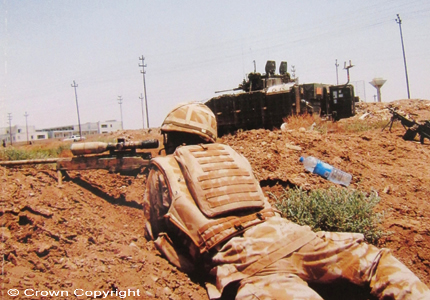|
A ‘FAREWELL TO ARMOUR’ AGAIN
THE DEMISE OF THE GUARDS ARMOURED INFANTRY ROLE
by Major General P G Williams CMG OBE
formerly Coldstream Guards
|

Grenadier officers at the Guards Armoured Division’s ‘Farewell to Armour’ parade
at Rotenburg on 9th June 1945
|
The Scots Guards regimental intelligence in this magazine’s Summer 2014 edition signalled the end of a quarter of a century of Foot Guards battalions in the Armoured Infantry role in one short sentence: ‘Having handed over Warrior armoured fighting vehicles, the Battalion has re-subordinated to a new brigade (12 Mech), re-written doctrine and rehearsed the various aspects of mechanized infantry’.
As an event this change of role in Catterick may not have been directly comparable to the Guards Armoured Division’s ‘End of Armour’ parade at Rotenburg airfield, near Hamburg, on 9th June 1945, at which Field Marshal Montgomery inspected the parade and addressed the Division, but the demise of the Armoured Infantry role in 2014 deserves a fuller treatment than just a single, under-stated sentence.
During the 1960s and 1970s the Foot Guards Mechanised Infantry battalions in 4th Guards Armoured Brigade had been equipped with FV432 Armoured Personnel Carriers. Little more than a ‘battlefield taxi’ for the rifle companies, the FV432 served then (and continues to serve both in Armoured and Mechanised Infantry battalions) as the platform for 81mm Mortar Platoon and for its armoured ambulances; neither of these specialised roles could be fulfilled by the FV432’s replacement because every FV510 Warrior came equipped with a turret.
For its part, the Guards Armoured Infantry role was synonymous with the Warrior Armoured Infantry Fighting Vehicle (AIFV). Jonathan Lloyd’s article in this edition reveals how the new vehicle underwent its Troop Trial in 1988 in the hands of No 2 Company, 1st Battalion Grenadier Guards in Münster before being rolled out more widely in the other battalions that had been chosen to become Armoured Infantry.
Warrior had barely settled into its originally envisaged role as a counterpart to the Warsaw Pact’s BMP-series AIFVs, when received its initial ‘blooding’ during the first Gulf War in 1991. There the Grenadiers were one of the three Armoured Infantry battalions in 4th Armoured Brigade; a fourth Warrior battalion was part of 7th Armoured Brigade. By the time Operation GRANBY had played its part in the successful liberation of Kuwait, this new AIFV had proved itself to be fully capable of keeping up with the Challenger main battle tanks and to be well suited to a battlefield on which manoeuvre and firepower were the keys to success on the ground.
The Warrior next found itself in a theatre and a role for neither of which it had been specifically designed and developed: on peacekeeping operations with the Coldstream in Bosnia and later with the Micks in Kosovo. Once again it acquitted itself well, despite its limited capabilities where communications were concerned; its VHF radios proved themselves to be poorly suited to the mountainous conditions in the Balkans. My article, also in this edition, describes how the camouflaged Warrior was transformed into a white UN peacekeeping vehicle.
The Warrior finally returned to an adversarial combat role in Iraq and later in Afghanistan, where unsurprisingly it once again proved to be a very capable and much respected component of the British contributions to Operations TELIC and HERRICK.
During its quarter of a century in the hands of Guards Armoured Infantry battalions only the Welsh Guards missed out on the opportunity to be a Warrior-equipped battlegroup. However, a number of Welsh Guardsmen, and even a few Household Cavalry 30mm gunnery experts, did serve with distinction in the Armoured Infantry Manning Increment that was established to boost the manpower and maintain the continuity of expertise in the Guards Armoured Infantry battalions in Münster and then in Catterick.
There may not have been a ‘Farewell to Armour’ parade to mark the end of this era, but Warrior served the Foot Guards well and will be remembered with affection by all those who were fortunate enough to have been a part of the Guards Armoured Infantry.
 A Grenadier sniper and a Warrior in overwatch position near Al-Amarah, Iraq in 2006
A Grenadier sniper and a Warrior in overwatch position near Al-Amarah, Iraq in 2006
|
|
|


